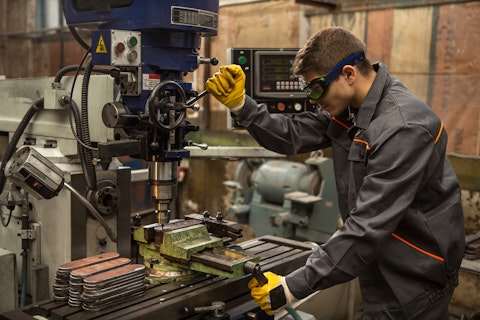In this article, we will look at the 26 most dangerous jobs in the world. If you want to skip our detailed analysis, head straight to the 10 Most Dangerous Jobs in the World.
While we live in a world where safety often takes the forefront of our priorities, there remain jobs that defy the norm. These exist some of the deadliest jobs, where every day on the job is a high-stakes gamble with life and limb. From firefighters battling towering infernos to deep-sea fishermen confronting the unforgiving oceans, some jobs require individuals to play with dangers every now and then. This puts organizations and companies to the test that must ensure safety precautions for their workers and thus, observe no negligence.
Historical Evidence of How Negligence Costed Workers’ Lives at Workplaces
One of the most notorious instances of corporate negligence that resulted in worker fatalities occurred at the Triangle Shirtwaist Factory in New York City. The factory’s owners, Max Blanck and Isaac Harris, prioritized profit over the well-being of their workers which eventually led to a catastrophic loss of life on March 25, 1911. The absence of adequate fire escapes and extinguishing equipment left the predominantly young immigrant women employees in a dire situation when a fire erupted on the eighth floor.
With locked exits and stairwells, they were trapped in a burning building which rendered escape impossible for many. As a result, 146 lives, mostly those of Italian and Jewish immigrant women and girls aged 14 to 23, were lost. The absence of proper safety measures not only contributed to the high casualty count but also highlighted the callous disregard for worker safety during that era. However, it is worth mentioning how this horrific incident catalyzed significant changes in labor laws and regulations while emphasizing the critical importance of workplace safety standards to protect workers from such avoidable catastrophes.
In addition, the Bhopal Gas Tragedy in India remains one of the most devastating industrial disasters in history. Union Carbide, an American chemical company, operated a pesticide plant in Bhopal. Negligence in maintaining safety standards, poor equipment maintenance, and inadequate employee training contributed to a massive gas leak of methyl isocyanate on December 2, 1984. Thousands died, and many suffered lifelong health issues as a result. In this case, the company’s negligence and delayed response have pushed the global urgency to realize the need for stringent safety measures and corporate accountability.
Companies Committed to Worker Safety
While there has been an irresponsible attitude toward workers’ safety by corporations around the world, there are some names that have always been at the forefront of addressing the safety concerns of their employees. 3M Co (NYSE:MMM) cares for worker safety by producing an extensive range of safety products that include N95 respirators, ear protection, innovative fall protection gear, and reflective materials to improve visibility for workers.
Transitioning to their financial performance in the second quarter of 2023, 3M Co (NYSE:MMM) reported adjusted earnings of $2.17 per share and surpassed the Zacks Consensus Estimate despite a double-digit decline year over year. This decrease can be attributed to pre-tax restructuring charges of $212 million. On the revenue front, 3M Co (NYSE:MMM)’’s quarterly net sales of $8,325 million exceeded expectations but still with a 4.3% year-over-year decline. Regionally, the Americas experienced a 1.5% decline in sales, while the Asia Pacific region saw a 12.8% decrease. Sales from Europe, the Middle East, and Africa, on the other hand, observed a modest increase of 0.6%.
Like 3M Co (NYSE:MMM), Honeywell International Inc (NASDAQ:HON) is also dedicated to ensuring worker safety through their comprehensive range of services and products. They not only provide the right Personal Protective Equipment (PPE) but also educate workers on its proper usage. Honeywell Safety Services offers expert guidance by conducting assessments and training to help employees understand the most suitable PPE for their specific work environments and associated hazards.
Honeywell International Inc (NASDAQ:HON)’s safety measures for their employees extend to real-time monitoring solutions for gas detection management to offer support, calibration assistance, device repairs, and troubleshooting. Their extensive safety training programs educate thousands of workers on-site, at customer locations, and in training centers. With a focus on individualized hearing conservation programs, Honeywell International Inc (NASDAQ:HON) takes worker safety to the edge, as they recognize how each worker’s safety needs are unique.
Ensuring workers’ safety is one of the integral aspects of a company’s ESG indicators. Socially conscious investors have been paying increasing attention to how companies have been improving their ESG indicators. Many, however, still question whether ESG-based investments are financially rewarding. In this regard, Stern School of Business did a meta-analysis of a 1,000 studies on ESG, carried out between 2015-2020, and arrived at the conclusion that the correlation between ESG and corporate financial performance was positive and statistically significant for 58% of the studies.

Nestor Rizhniak/Shutterstock.com
Methodology
To determine the most dangerous jobs in the world, we acquired data of Fatal Injury Rate per 100,000 people from the U.S. Bureau of Labor Statistics Census of Fatal Occupational Injuries. The list is presented in ascending order.
In case of similar fatal injury rates, the job with higher total fatalities in 2019 was ranked higher. For data on total fatalities in 2019, we acquired our data from Advisorsmith.
Important Note: Please note that our list does not include any military or security contractor jobs despite the perceived relatively high-risk nature of these jobs. Data shows that the fatality rate in the US Army for on-duty soliders is 1.3 per 100,000 individuals, which is actually much lower than those of many of the civilian professions.
26. Security Guard
Fatal Injury Rate: 7 per 100,000
Security guards are frequently exposed to potential threats like theft, vandalism, and violent confrontations. They work in high-risk environments, like banks or nightclubs, where conflicts can escalate quickly. Moreover, limited access to advanced training and protective gear compared to law enforcement personnel also adds to their vulnerability.
25. Carpenters
Fatal Injury Rate: 8 per 100,000
Carpenters often work with heavy machinery, power tools, sharp objects, and at heights, which can lead to injuries. Fatalities can occur from falls, electrical accidents, equipment malfunctions, and inadequate safety measures. To read about the most demanded jobs, check our article on the 20 Most In-Demand Jobs for the Future.
24. Mining Machine Operators
Fatal Injury Rate: 11 per 100,000
Mining machine operators face difficulty and danger due to working in confined, unstable underground environments with heavy machinery, explosives, and exposure to toxic gases. Their job demands precision, constant vigilance, and adherence to safety protocols to avoid accidents and health hazards.
23. Construction Workers
Fatal Injury Rate: 13 per 100,000
Construction workers face a number of dangers like falls from heights, heavy machinery accidents, electrical shocks, and exposure to toxic substances. Insufficient safety measures, inadequate training, and rushed deadlines can contribute to fatalities in the construction industry, making it one of the most dangerous professions globally.
22. Heavy Vehicle Mechanics
Fatal Injury Rate: 14 per 100,000
Heavy vehicle mechanics work with heavy machinery, potentially toxic chemicals, and high-pressure equipment. Thus, the job involves serious risks like crushing injuries, burns, and exposure to harmful substances. Additionally, working in tight spaces or at heights can increase the likelihood of accidents. The number of total fatal injuries in 2019 was 27.
21. General Maintenance and Repair Workers
Fatal Injury Rate: 14 per 100,000
Repair and maintenance work can be dangerous because of the exposure to toxic materials, while working with heavy machinery. These workers sometimes work at elevated heights which further adds to the danger at their jobs. Moreover, inadequate training, equipment malfunction, and poor safety protocols can increase the risk of accidents. It is one of the riskiest jobs in the world. The number of total fatal injuries in 2019 was 78.
20. Police Officers
Fatal Injury Rate: 14 per 100,000
The high fatality rate among police officers is influenced by their exposure to potentially life-threatening situations while enforcing the law. The widespread prevalence of firearms in the region can also lead to armed confrontations and thus, also contribute to the danger involved. The number of total fatal injuries in 2019 was 186.
19. Grounds Maintenance Workers
Fatal Injury Rate: 14 per 100,000
Ground maintenance workers face danger because of the high fatality rates involved, often caused by car accidents while traveling to job sites or falls, slips, and trips during work. It is one of the most dangerous jobs in the world. The number of total fatal injuries in 2019 was 229.
18. Small Engine Mechanics
Fatal Injury Rate: 15 per 100,000
Small engine mechanics work with potentially volatile fuels, sharp tools, and intricate machinery, They must troubleshoot complex systems and often work in cramped spaces which require technical expertise, precision, and safety precautions to prevent accidents and injuries. The number of total fatal injuries in 2019 was 8.
17. First-Line Supervisors of Mechanics, Installers, and Repairers
Fatal Injury Rate: 15 per 100,000
The job of supervisors of mechanics, installers and repairers can be potentially fatal due to their responsibilities involving oversight of potentially hazardous industrial machinery and operations. They must ensure safety protocols are followed, and any lapse in supervision can lead to accidents, injuries, or even fatalities among the workers they oversee. The number of total fatal injuries in 2019 was 44.
16. Cement Masons
Fatal Injury Rate: 17 per 100,000
Cement masons are involved in heavy lifting and are exposed to toxic materials like wet concrete while working in adverse weather conditions. Their job demands physical stamina, skill in concrete finishing, and strict adherence to safety measures to prevent injuries and health risks. It is one of the top dangerous jobs in the world.
15. Landscaping Supervisors
Fatal Injury Rate: 18 per 100,000
Landscaping supervisors oversee outdoor projects with potential dangers like heavy machinery operation, tree work, and pesticide use. They’re responsible for safety protocols, and their job often includes coordinating activities in potentially risky environments. The number of total fatal injuries in 2019 was 20.
14. Highway Maintenance Workers
Fatal Injury Rate: 18 per 100,000
Highway maintenance workers play with danger as they work in fast-moving traffic, and extreme weather conditions, and are frequently exposed to heavy machinery and hazardous materials. Their job requires constant vigilance and manual labor. The number of total fatal injuries in 2019 was 21.
13. Construction Helpers
Fatal Injury Rate: 18 per 100,000
A construction helper’s job is dangerous owing to their exposure to heavy machinery, heights, and hazardous materials. They face risks like falls, equipment accidents, and exposure to chemicals. It is one of the most deadliest jobs in the world.
12. Crane Operators
Fatal Injury Rate: 19 per 100,000
The job of a crane operator can have fatal risks of accidents like crane collapses, load failures, or contact with power lines. Operator errors, equipment malfunctions, or adverse weather conditions can lead to deadly incidents. The number of total fatal injuries in 2019 was 8.
11. Crossing Guards
Fatal Injury Rate: 19 per 100,000
Crossing guards are in close proximity to moving vehicles and are responsible for the safety of pedestrians, especially children. They face risks from distracted or reckless drivers, tough weather conditions, and the unpredictable behavior of pedestrians. The number of total fatal injuries in 2019 was 20.
Click here to see the 10 Most Dangerous Jobs in the World.
Suggested Articles:
- 20 Most Dangerous Countries in Asia
- 20 Most Dangerous Countries in Europe
- 12 Most Dangerous Countries in Central America and South America
Disclosure: None. 26 Most Dangerous Jobs in the World is originally published on Insider Monkey.





